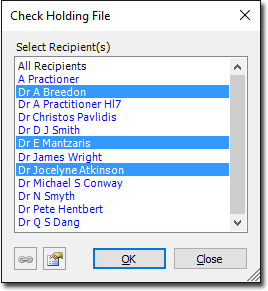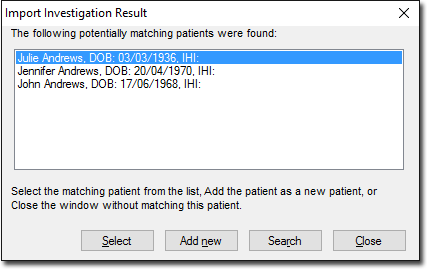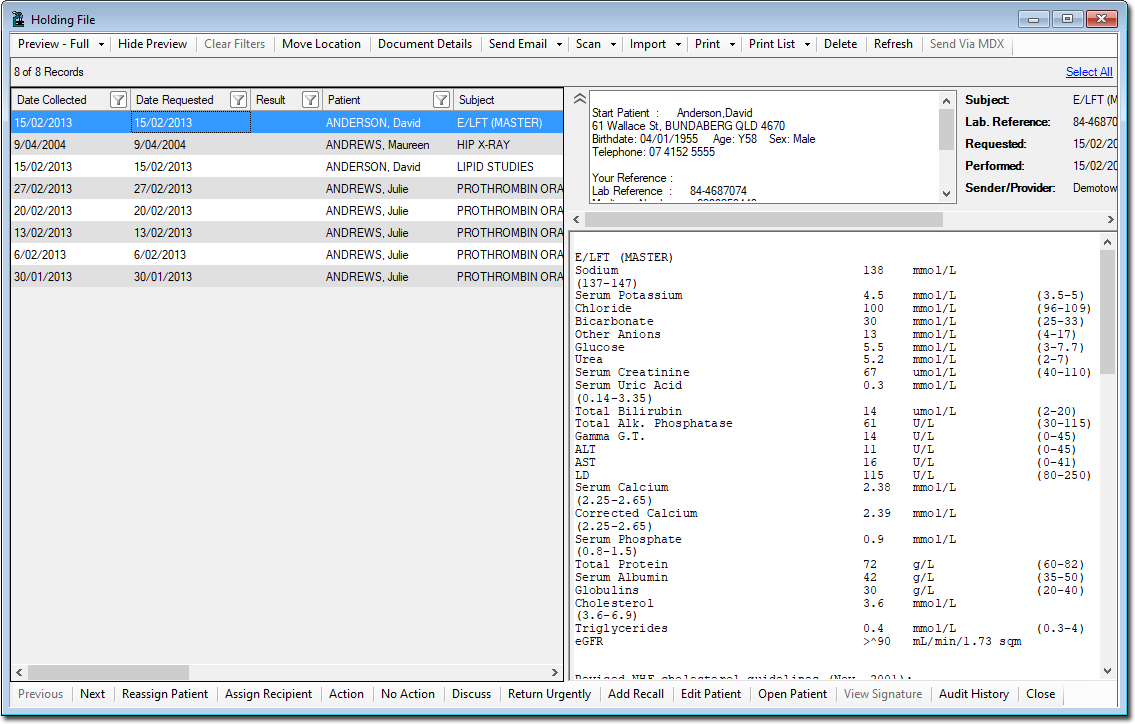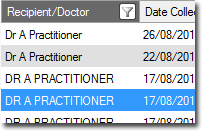Holding File for All Patients
Before you begin
Procedure
- Select .
-
You will be prompted to select one or more recipients whose results you wish to examine.

-
From this window select the recipient(s) whose results you wish to examine:
- Select a single recipient by clicking their name, and then clicking OK to open the Holding File to display only their results. Alternatively you can double-click a name to simultaneously select them and open the Holding File.
- Select multiple recipients by clicking each name. To deselect a name, simply click it again. Then, click OK to open the Holding File to display only the results of the selected recipients.
- Select all recipients by clicking the All Recipients option. Clicking OK then opens the Holding File to display results for all recipients. Alternatively you can double-click the All Recipients option to simultaneously select all recipients and open the Holding File. Note that, as making a selection from this window locks the results associated with the selected recipient, it is recommended that you select only a specific recipient, as selecting All Recipients will prevent others from accessing any results whilst you have the Holding File open.
When you receive an Investigation Result from a laboratory, the result should be associated with your user name as it appears in Clinical. However, this is not always the case - sometimes the laboratory may use an alias to refer to you in its system.
Consider the scenario where a user called Dr. A Practitioner receives results for multiple aliases that include 'Dr. A Practitioner', 'A. Practitioner', 'Dr. Anthony Practitioner', and 'Dr. Tony Practitioner', depending on which laboratory the results have come from. Determining which results are associated with which recipient record in Clinical can be confusing, particularly if your database contains multiple users who have the same or similar names.
To account for this, Clinical provides a facility for managing these user aliases. This tool allows you to;
Link one or more aliases with your user name in Clinical.
Automatically assign all results for these aliases with your user name when the Holding File is next opened.
Manage any alias-to-user links you have established.
- You will then be presented with the Holding File.
-
(Optional) Upon opening the Holding File, the first result in the list is
automatically selected and displayed. If Clinical cannot determine which patient the
result relates to, you will be prompted to either add a new patient to the database
(by clicking Add New), or select from a list of patients the
result could possibly belong to, as seen in the following example.

You may also be presented with these prompts as you browse through the list of results.
- Rearrange the column order by clicking and dragging a selected column, and dropping it to a new location.
- Sort the list of Results by clicking on any column heading. The sort order of
a column is indicated via the direction of the
 icon.
icon. - Multiple records can be selected simultaneously using the CTRL or SHIFT keys, as per standard Windows functionality.
- Simple/Advanced filtering can be applied to this window. In the example above, the Recipient/Doctor column has been filtered;

See Filtering/Searching Correspondence Records for more information.
- Within the Holding File you can check-off Results. See Checking Off New Results for information.
-
Review the table below for information on using the Holding File.
Items of interest on the Holding File window: Note:the range of options available to you will be limited by the level of access you have. See the Permissions Matrices below for more information.See also Keyboard Shortcuts.
Upper Section Clear Filters Click the button to clear all filters. When this button appears greyed-out, it indicates that no filters have been applied. Comment Details of any comments recorded. Date Collected The date on which the sample was taken from the patient. Date Created The date on which the result was created by the laboratory. See also 'Date Requested'.
Date Notified The date on which the notification for this test was made. Delete Click to delete selected entries. Document Details Click to edit the details of a selected Result. Use the button also to view large document descriptions. Edit > Copy Result Copy a selected item's content to the clipboard. File > Add Cervical Screening Allows you to manually add Cervical Screening results for a selected patient (female or gender-neutral, >15 years of age). File > Mark for Recall Create a Recall notification for the patient. ERROR: Variable (Recall_Management) is undefined. File > Outstanding Requests Opens the Outstanding Requests window. Hide/Show Preview Hides/Reveals the preview pane. Import Click to import a document directly into the Holding File, after which you can assign the document to a patient, via the button (see above). Move Location Click to move selected Results to a specific tab within the patient's record. You can select from the Documents, Letters or Results tabs in the Clinical Window, or the ECG tab of the Tool Box. Notation Details of any notation that has been made. Open Externally Opens the selected document in the default third-party application, for viewing externally to Clinical. Only available to records that must be opened by a third-party application. Patient The name of the patient associated with the select result. Patient > Open Calls the 'Select Patient from List' window, allowing you to open any patient's record. Patient > Open Patient Opens the record of the selected patient. Preview Controls the display of a selected document's details. Options are 'Full', 'Bottom', and 'Right'. The image above shows that 'Bottom' has been selected, and the details of the selected document are visible in the lower half (bottom) of the window. Print / Print To *Include Patient Header
Prints every page of every multi-page document within every selected record; Print: Prints to the Letter Writer printer.
Print To: By clicking the
 next to
the Print button, you can specify where you
want to send the print job by calling the Windows print
window.
next to
the Print button, you can specify where you
want to send the print job by calling the Windows print
window.The 'Include Patient Header' option will print the patient's demographic data that appears at the top-left of an item, as shown in the example below. Most results include this information already, so it would normally be unnecessary for you to select this option. You can set whether this option is active or not by default via Investigations Options.

Print List / Print List To Prints a list of selected documents. Note that the details of the selected documents are not displayed on the printout. Print: Prints to the Letter Writer printer.
Print To: By clicking the
 next to
the Print button, you can specify where you
want to send the print job by calling the Windows print
window.
next to
the Print button, you can specify where you
want to send the print job by calling the Windows print
window.Recipient/Doctor The name of the recipient of the test. Refresh Refreshes the window. Result E.g. 'Normal', 'Abnormal'... Scan Click to scan a document directly into the Holding File, after which you can assign the document to a patient, via the button (see above). Sender/Provider The name of the laboratory that conducted the test. Source E.g. SDI, imported, scanned. Subject The name of the test ordered. Type Indicates the type of test (e.g. Pathology, Cytology etc) User Name The name of the user who imported the file. For SDI results, the name of the computer on which the file was imported. Zoom Select a zoom option fro the drop-down list provided. Only available to records that can be zoomed, such as photographs. Lower Section Action Calls the Action window, which allows you to indicate which sort of action you would like to take regarding this Result. Such actions include 'Discuss', 'Return Urgently' and so forth. You can also create customised Actions, which will be saved for later use. For more information about Actions, see Adding Results Manually. Use this button also to view large comments.
Add Recall Click to create a Recall notification for the patient. Assign/Reassign Patient Assigns the selected result to the patient. If no matching patient record can be found, you will be prompted to either add a new patient or search for an existing patient to match the result to. Assign/Reassign Recipient Click to assign the selected Result to a specific recipient. If the Result is already associated with a recipient, clicking this button allows you to assign it to another. Audit History Toggles half of the viewing area to display an audit trail of changes made to a selected Result. The following events are tracked:
When a record is assigned or reassigned to a patient.
When a record is assigned or reassigned to a recipient.
When a notation of 'No Action' is applied to a result, and by whom.
When a notation is applied to a result, and the comment that is recorded against it.
The name of the user who recorded a notation.
When a record is moved between tabs in the patient's clinical window, the 'from' tab and 'to' tab are recorded, and the name of the user who moved the record.
When a record is flagged as being 'Notified/De-notified', plus the name of the user who made the change, and the date on which this occurred.
The name of the user who conducts a scan.
The name of the user who imports a result.
Close When viewing the Holding File, clicking this button closes the Holding File. When viewing an individual record in 'full view', clicking this button closes the record and returns you to the Holding File.
Discuss Click to indicate that you wish to discuss the result with the patient. Edit Patient If the demographic details on the Result are incorrect, i.e. they do not exactly match an existing patient in the database, you can edit the demographics in the result by clicking this button. Modify the details as required, ensuring that the information is correct for the intended patient. After editing, MedicalDirector Clinical will try to rematch with a patient in the database. No Action Click to indicate that no actions are required regarding the selected Result. Return Urgently Mark the selected item as 'Return Urgently'. Open Patient Click to open the clinical record of the patient associated with the selected record.. Previous/Next Click to scroll through the list of records, displaying the details of each, one-by-one. View Signature Click to view details about the digital signature used for a selected e-mail in the Holding File, imported via MDExchange.
